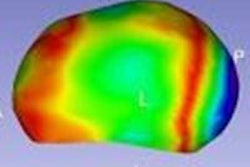CT protocols are getting more complex with each new scanner generation, challenging even the best-run radiology departments. Fortunately, a comprehensive protocol plan can minimize the fuss -- and the potential for dangerous mistakes, according to a talk at the Virtual Symposium on Radiation Safety and Computed Tomography.
The fact that protocols are in constant flux due to new software, hardware, knowledge, insurance requirements, and patients in every size and shape doesn't make things any easier. But these things are manageable when everyone's role is clear and tasks are well-defined, according to Christopher Cagnon, PhD, professor of health sciences at the University of California, Los Angeles.
Protocol management got a lot harder after a series of well-publicized errors, most infamously at Cedars-Sinai Medical Center in Los Angeles in 2009, when several patients undergoing perfusion CT of the head were given extraordinarily high radiation doses.
"Some of the discussions around the incidents involved the technologist's roles and responsibilities, primarily things behind the scan protocol: who designed them, who implemented them, who adjusted them, and who makes adjustments on the fly," Cagnon said at the recent symposium, which was sponsored by the University of California, San Francisco.
Lack of standardization
There are many causes underlying most radiation incidents, the most common being a lack of protocol standardization and poor understanding of protocols and equipment capabilities, Cagnon said. In testimony before the U.S. Congress, it came out that some of the accidents involved questions of oversight; for example, whether CT technologists are the ones who irradiate the patient, and which protocols are actually being used, Cagnon said.
Of course, it's radiologists who actually determine CT use, but there are very few guidelines available, and protocols can vary markedly between scanner models.
"There is potential for practice variation within institutions, across institutions, across scanner platforms, and even among a single model of CT scanners," Cagnon said. "There is concern over scanner calibration, but most accidents are the result of operator error and poor understanding or implementation of CT protocols or supervision."
Complex new software is released frequently for almost every scanner in the facility; meanwhile, protocols can vary across vendors, and experience with one scanner does not mean proficiency with another. The host of players who contribute to protocols is also broad, and they all have their own role, Cagnon said:
- Radiologists are responsible for CT protocols, particularly in California. They read images but have limited knowledge and technical expertise.
- Medical physicists are highly trained and focused on equipment calibration, but they have little involvement with the scan or the clinical question it aims to answer.
- Technologists have the most knowledge of vendor protocols but the least knowledge of physics and the technical principles involved.
- Vendors have the most experience with the machines, but they aren't responsible for patients.
Changing everything
CT scanners are regularly calibrated and are actually quite stable in their radiation output, but changing the settings changes everything, Cagnon said.
"It's the protocols that directly affect the scanner output, and there are myriad vendor-specific and highly variable protocols that are not regulated and have a big effect on dose," he said.
Translation: The error is all in the protocol, and technologists can run into a lot of complications trying to make sense of it all.
For example, maybe the referring physician wants a certain type of exam, but what he orders isn't quite right for the indication. Scanner and patient delays can result from the need to contact and resolve the discrepancies, and reimbursement can be affected as well, Cagnon said.
It's the radiologist's job to work with the referring physician to order the right exam, "but in our current economy, radiologists are driven by [relative value units (RVUs)]; they may not always be motivated to spend time educating or interacting with physicians," Cagnon said. "The technologist may end up moderating or caught in the middle between the referring physician and the radiologist."
The use of insurance workarounds -- "where you're ordering one type of exam that might be reimbursed when the requesting physician wants another type" -- is common, he said. That practice brings the challenge of providing the requested data when the reimbursed exam wouldn't necessarily include it. The scan might need to include additional series or reformats if the necessary information isn't included in the protocol, Cagnon said. Say the referring doctor orders routine CT, while the study indication calls for CT angiography. The referring physician must be contacted to revise the order, which is time-consuming.
"It's a patient dilemma, too," Cagnon said. "Do you do the scan anyway and risk a denial of payment, or do you postpone the scan and reschedule the patient? Perhaps they've come from far away, or maybe they've already started drinking their contrast, etc. These are all real-life challenges we face every day."
Then there's Obamacare
Changes are also afoot with regard to the Patient Protection and Affordable Care Act (PPACA), aka Obamacare, set to begin next January, Cagnon said.
"It's probably not going to be long before payments are capped as part of the Obamacare effort," he said. "The new healthcare regulations may require payment based on outcomes rather than actual exams ordered. So whatever exams are ordered by the hospital is up to them, but they would only actually get a fixed payment."
The outpatient environment will be different, he said. Technologists and physicians will have to decide whether the actual exam ordered is covered by insurance. If not, alternatives will have to be explored. Maybe the patient would rather proceed with a disallowed exam for a cash payment.
Essential in all of the back and forth is a good relationship between the technologist and the radiologist to determine whether the exam is appropriate and will be paid for, or if not, what else can be done to deliver the imaging that is needed, Cagnon said.
Each year brings more intense focus on dose-saving strategies, but they can be difficult to implement without thorough review, and if they're implemented incorrectly, they can adversely affect patient care, he said. For teaching institutions, it becomes a question of exactly who is making the call.
"If you have a resident on call, they might not have the experience and may have to rely on the technologist to make the call, which leads to the question of whether the attending radiology specialist is available to solve problems," Cagnon said.
Setting protocols
The protocols should include the full range of technical and clinical management factors, which should be detailed and made available to everyone involved in the scan, according to Cagnon. Depending on the size of your institution, your CT protocol team should include the radiology subspecialist -- for example, the neuroradiologist -- in addition to the technologist, the medical physicist, and the protocol technologist, who is responsible for implementing the protocols on the different scanners. This last position could be a stretch for smaller institutions, but it is ideal, he said.
Protocols should be periodically reviewed and harmonized on each scanner, he said. Each protocol should be signed off by the radiologist. Optimally, the physicist can look at things such as dose and collimation and provide some additional valuable information.
The shared and unique responsibilities of each member of the protocol team should be documented. The documentation should separate protocol types by scanner model. Establish standardized anatomic positioning, scan lengths, and technical factors, using images whenever appropriate. Don't forget the contrast information, and the identification of dose reduction opportunities, Cagnon noted.
"Please remember that things will and should change," he said. "Implement a change control process if you're going to have revisions [to determine] who reviews them, who signs off on them, and who has access after you program the scanner."




















